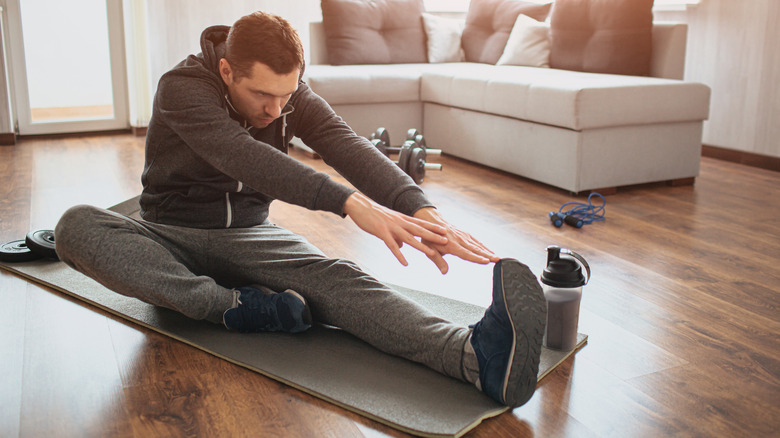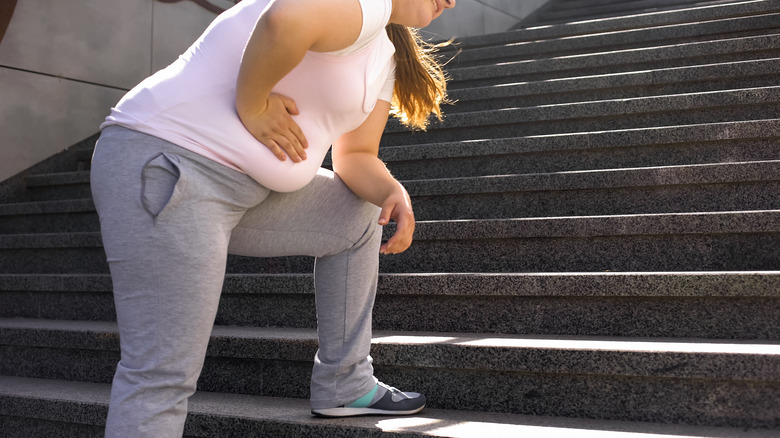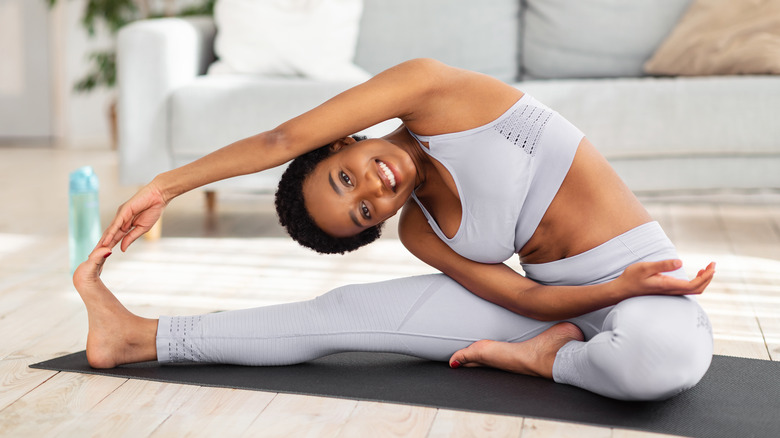Is Ballistic Stretching Before A Workout Actually Good For You?
As a kid, you may have been instructed to do a butterfly stretch or to touch your toes during gym class. The concept of bouncing your knees up and down to achieve a deeper butterfly stretch or trying to push your arms closer and closer to your toes is a form of stretching called ballistic stretching, which relies on the movement of other muscles to attain a deeper stretch (per The Healthy). However, is ballistic stretching actually good for you?
Regular stretching can help maintain muscle flexibility, take a load off of your joints, and keep your body in all-around better shape, according to Harvard Health Publishing. If you don't stretch regularly, then you risk your muscles becoming shorter and tighter, putting yourself in jeopardy of injury. But stretching comes in many forms, and the type of stretching you practice can impact your health.
Passive stretching is what most likely comes to mind when you think about stretching before a workout (via The Healthy). When you perform a passive stretch, you find a position where you can feel a muscle stretch and then you hold that position for a certain amount of time, usually 20 seconds to a minute.
Ballistic stretching takes passive stretching to the next level by using bouncing motions and momentum to stretch the target muscle. When you practice ballistic stretching, the momentum from bouncing back and forth forces muscles into deeper stretches, rather than allowing muscles to stretch organically.
Ballistic stretching can lead to injuries
The bouncing motion and forceful stretching of muscles during ballistic stretching can lead to injury, reports Healthline. When these stretches are performed, there is a significant chance of straining or pulling a muscle since forceful stretches can cause damage to the soft tissue around joints, ligaments, and tendons. Ballistic stretching can lead to tendonitis and repeated small tears of muscles during forceful stretches can actually decrease mobility and flexibility over time as scar tissue builds up and muscles become too damaged.
Because of the high risk of damage to muscle, tissue, and joints, ballistic stretching isn't recommended by stretching professionals and medical specialists. In fact, both the American College of Sports Medicine and the American Academy of Orthopaedic Surgeons warn against ballistic stretching and other forms of stretches involving bouncing. Trainers also don't recommend them. Erica Ziel told Well+Good. "Stay far, far away from ballistic stretches."
If you want to touch your toes, do so gently and be compassionate with yourself. Performing ballistic stretching and bouncing back and forth in a position that puts strain on your lower back can lead to back pain and spinal injuries, including herniated discs. Ballistic stretching that pulls momentum from your lower back can put you in a position of vulnerability because of pressure placed on spinal discs and surrounding ligaments. Forceful stretching of your hamstrings can lead to pulled muscles and pain in multiple parts of your body (per AICA Orthopedics).
Try active stretching instead
Instead of ballistic stretching, another type of stretching that can help you gain flexibility without injury is active stretching (per The Healthy). Also referred to as static-active stretching or dynamic stretching, active stretches focus on the active contractions of target muscles to increase flexibility and mobility.
You can think of active stretching as a healthy middle ground between passive stretching and ballistic stretching. Like passive stretching, active stretching involves moving into a position where you feel a stretch. But, unlike passive stretching, where you maintain the position for a predetermined amount of time, active stretching presupposes that you allow your body to slowly lean deeper into the stretch using contraction-based movement instead of bouncing.
Active stretches are typically held for only 10-15 seconds, reports Healthline. This form of stretching allows you to stretch multiple muscles simultaneously since the active contraction of one muscle will stretch an opposing muscle without any external force.
One example of an active stretch is to lift your leg straight up to the ceiling as you lay flat on your back. Once you feel your hamstring begin to stretch, contract it and hold it for a few seconds. Contracting your hamstring will create a static stretch while also working your core and hip flexors.
While active stretching can be performed before a workout, it is often conducted after exercise. Some studies have discovered decreased muscle strength after doing active stretches pre-workout (via Frontiers in Physiology and the Journal of Physical Therapy Science).



